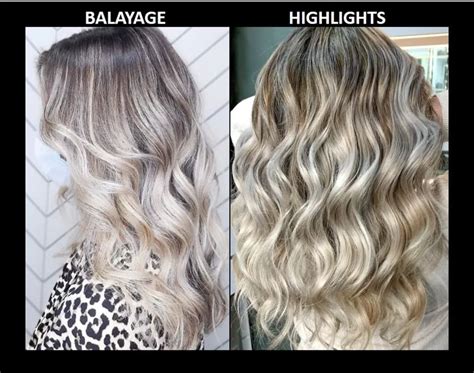In the world of hair coloring, balayage and highlights hold a special allure. These techniques promise to enhance your natural hue, add depth, and create a sun-kissed look. However, while both offer stunning results, they differ in their approach, appearance, and suitability for various hair types. Understanding these differences is crucial for making an informed decision that complements your desired look.

1. Technique: The Art of Application
- Balayage: This freehand painting technique involves applying lightener directly to the surface of individual hair strands, creating a subtle, natural-looking gradient.
- Highlights: Foils or caps are used to isolate sections of hair, which are then lifted with a color-lightening solution. This creates a more defined and contrasting effect.
2. Appearance: Gradual vs. Defined
- Balayage: Balayage results in a soft, gradual transition from dark to light tones. The absence of harsh lines creates a blended, sun-kissed effect that flatters most hair types.
- Highlights: Highlights provide a more defined, brighter contrast between the lightened sections and the base color. This creates a bolder, more noticeable effect that may not suit all hair textures or face shapes.
3. Maintenance: Effortless vs. Regular
- Balayage: Regrowth with balayage is less noticeable and requires less frequent touch-ups (every 3-6 months) compared to highlights.
- Highlights: Highlights require more regular maintenance (every 6-8 weeks) to prevent noticeable root growth and maintain the desired contrast.
4. Hair Damage: Minimal vs. Moderate
- Balayage: Balayage tends to be less damaging to hair, as it involves less chemical processing. The lightener is selectively applied to only the desired strands, avoiding excessive exposure to the scalp.
- Highlights: Highlights require more extensive use of color-lightening solutions, which can lead to more hair damage if not applied properly.
5. Cost: A Matter of Finance
- Balayage: Balayage is generally more expensive than highlights due to the time-consuming freehand technique and the expertise required.
- Highlights: Highlights are typically less expensive, as the process is more standardized and requires less skill to execute.
6. Styling: Versatility vs. Structure
- Balayage: The blended effect created by balayage allows for greater styling versatility. It complements both sleek and natural hairstyles, providing a subtle yet noticeable enhancement.
- Highlights: Highlights provide more structure to the hair, creating a more defined and bold look that may require specific styling techniques to achieve the desired effect.
7. Suitability: The Right Choice for Your Hair
- Balayage: Balayage is ideal for those who desire a natural-looking, low-maintenance hair color with minimal damage. It is particularly suitable for dark hair, adding dimension without a stark contrast.
- Highlights: Highlights are a suitable choice for those who prefer a more dramatic, contrasting effect. They work well on both light and dark hair, providing a bolder and more noticeable transformation.
Conclusion: A Decision of Style
Choosing between balayage and highlights depends on your personal style, hair type, and desired look. Balayage offers a natural, effortless enhancement with minimal maintenance, while highlights provide a more defined, bold effect that requires regular touch-ups. Ultimately, the best choice for you is the one that aligns with your aesthetic preferences and hair care goals.
Q: Which technique is less damaging to hair?
A: Balayage is generally less damaging than highlights, as it involves less chemical processing.
Q: Which technique requires less maintenance?
A: Balayage requires less frequent touch-ups compared to highlights.
Q: Which technique is best for dark hair?
A: Balayage is ideal for adding dimension and subtle highlights to dark hair.
Q: Which technique is more expensive?
A: Balayage is typically more expensive than highlights due to the time-consuming freehand technique.
| Feature | Balayage | Highlights |
|---|---|---|
| Technique | Freehand painting | Isolation of hair sections with foils or caps |
| Effect | Gradual, natural-looking | Defined, more noticeable |
| Hair damage | Minimal | Moderate |
| Feature | Balayage | Highlights |
|---|---|---|
| Maintenance | Less frequent touch-ups (every 3-6 months) | More regular touch-ups (every 6-8 weeks) |
| Cost | More expensive | Less expensive |
| Feature | Balayage | Highlights |
|---|---|---|
| Styling versatility | Greater versatility, complements both sleek and natural hairstyles | More structure, may require specific styling techniques |
| Suitability | Ideal for natural-looking, low-maintenance hair color | Suitable for more dramatic, contrasting effect |
| Feature | Balayage | Highlights |
|---|---|---|
| Hair damage | Less damaging | More damaging |
| Coloring time | Longer (2-4 hours) | Shorter (1-2 hours) |
